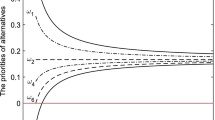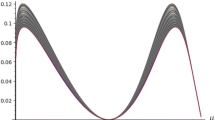Abstract
Deriving the priority vectors of the alternatives by preference relations is a vital research topic for decision making with preference information. In this paper, a novel method is provided to derive the intuitionistic fuzzy priority vectors (IFPVs) from intuitionistic fuzzy preference relations (IFPRs). Concretely, the multiplicative consistencies of IFPRs are characterized by the IFPVs and the group of constrained linear equations, respectively. Then, it is pointed out that there always exist \(2n-1\) constrained preference values based on which an acceptably multiplicative consistency is proposed, and a method to check and repair the acceptably multiplicative consistency of a complete or incomplete IFPR by reducing the distance between the optimal IFPVs and the local ones is provided. Some examples are given to show how the models work, and comparisons with the existing methods are also offered to demonstrate the advantages of the proposed method.








Similar content being viewed by others
References
Ahmed F, Kilic K (2019) Fuzzy analytic hierarchy process: a performance analysis of various algorithms. Fuzzy Sets Syst 362:110–128
Atanassov K (1986) Intuitionistic fuzzy set. Fuzzy Sets Syst 20:87–96
Beliakov G, Pradera A, Calvo T (2007) Aggregation functions: a guide for practitioners. Springer, Heidelberg
Beliakov G, Bustince H, Goswami DP, Mukherjee UK, Pal NR (2011) On averaging operators for Atanassov’s intuitionistic fuzzy sets. Inf Sci 181:1116–1124
Chen SM, Tan JM (1994) Handling multicriteria fuzzy decision-making problems based on vague set theory. Fuzzy Sets Syst 67:163–172
Chiclana F, Herrera F, Herrera-Viedma E (2001) Integrating multiplicative preference relations in a multipurpose decision-making model based on fuzzy preference relations. Fuzzy Sets Syst 122:277–291
Chiclana F, Mata F, Martínez L, Herrera-Viedma E, Alonso S (2008) Integration of a consistency control module within a consensus decision making model. Int J Uncertain Fuzziness Knowl Based Syst 16:35–53
Chiclana F, Herrera-Viedma E, Alonso S, Herrera F (2009) Cardinal consistency of reciprocal preference relations: a characterization of multiplicative transitivity. IEEE Trans Fuzzy Syst 17:14–23
Gau WL, Buehrer DJ (1993) Vague sets. IEEE Trans Syst Man Cybern 23:610–614
Guo KH (2014) Amount of information and attitudinal based method for ranking Atanassov’s intuitionistic fuzzy values. IEEE Trans Fuzzy Syst 22:177–188
Herrera-Viedma E, Herrera F, Chiclana F, Luque M (2004) Some issues on consistency of fuzzy preference relations. Eur J Oper Res 154:98–109
Hong DH, Choi CH (2000) Multicriteria fuzzy decision-making problems based on vague set theory. Fuzzy Sets Syst 114:103–113
Jin F, Ni Z, Chen H, Li Y (2016) Approaches to group decision making with intuitionistic fuzzy preference relations based on multiplicative consistency. Knowl Based Syst 97:48–59
Li C, Dong Y, Xu Y, Chiclana F, Herrera-Viedma E, Herrera F (2019) An overview on managing additive consistency of reciprocal preference relations for consistency-driven decision making and fusion: Taxonomy and future directions. Inf Fusion 52:143–156
Liao HC, Xu ZS (2014) Priorities of intuitionistic fuzzy preference relation based on multiplicative consistency. IEEE Trans Fuzzy Syst 22:1669–1681
Liao HC, Xu ZS (2015) Consistency of the fused intuitionistic fuzzy preference relation in group intuitionistic fuzzy analytic hierarchy process. Appl Soft Comput 35:812–826
Liao H, Xu Z, Zeng X, Merigo JM (2015) Framework of group decision making with intuitionistic fuzzy preference information. IEEE Trans Fuzzy Syst 23:1211–1227
Liu X, Pan Y, Xu Y, Yu S (2012) Least square completion and inconsistency repair methods for additively consistent fuzzy preference relations. Fuzzy Sets Syst 198:1–19
Ma ZM, Xu ZS, Fu ZW, Yang W Deriving the priorities based on representable uninorms from fuzzy preference relations. Fuzzy Sets Syst (submitted)
Orlovsky SA (1978) Decision-making with a fuzzy preference relation. Fuzzy Sets Syst 1:155–167
Saaty TL (1980) The analytic hierarchy process. McGraw-Hill, New York
Szmidt E, Kacprzyk J (2003) A consensus-reaching process under intuitionistic fuzzy preference relations. Int J Intell Syst 18:837–852
Tanino T (1984) Fuzzy preference orderings in group decision making. Fuzzy Sets Syst 12:117–131
Wan S, Xu G, Dong J (2016) A novel method for group decision making with interval-valued Atanassov intuitionistic fuzzy preference relations. Inf Sci 372:53–71
Wang ZJ (2013) Derivation of intuitionistic fuzzy weights based on intuitionistic fuzzy preference relations. Appl Math Model 37:6377–6388
Wang ZJ, Li KW (2012) Goal programming approaches to deriving interval weights based on interval fuzzy preference relations. Inf Sci 193:180–98
Wu J, Chiclana F (2014) Multiplicative consistency of intuitionistic reciprocal preference relations and its application to missing values estimation and consensus building. Knowl Based Syst 71:187–200
Xia M, Xu ZS (2012) Entropy/cross entropy-based group decision making under intuitionistic fuzzy environment. Inf Fusion 13:31–47
Xia M, Xu ZS, Chen J (2013) Algorithms for improving consistency or consensus of reciprocal \([0,1]\)-valued preference relations. Fuzzy Sets Syst 216:108–133
Xu ZS (2007) Intuitionistic fuzzy aggregation operators. IEEE Trans Fuzzy Syst 15:1179–1187
Xu ZS (2007) Intuitionistic preference relations and their application in group decision making. Inf Sci 177:2363–2379
Xu Y, Herrera F (2019) Visualizing and rectifying different inconsistencies for fuzzy reciprocal preference relations. Fuzzy Sets Syst 362:85–109
Xu ZS, Liao HC (2014) Intuitionistic fuzzy analytic hierarchy process. IEEE Trans fuzzy Syst 22:749–761
Xu ZS, Yager RR (2006) Some geometric aggregation operators based on intuitionistic fuzzy sets. Int J Intell Syst 35:417–433
Xu ZS, Cai XQ, Szmidt E (2011) Algorithms for estimating missing elements of incomplete intuitionistic preference relations. Int J Intell Syst 26:787–813
Xu Y, Herrera F, Wang HM (2016) A distance-based framework to deal with ordinal and additive inconsistencies for fuzzy reciprocal preference relations. Inf Sci 328:189–205
Xu G, Wan S, Wang F, Dong J, Zeng Y (2016) Mathematical programming methods for consistency and consensus in group decision making with intuitionistic fuzzy preference relations. Knowl Based Syst 98:30–43
Yang Y, Wang X, Xu ZS (2019) The multiplicative consistency threshold of intuitionistic fuzzy preference relation. Inf Sci 477:349–368
Zhang H (2016) Group decision making based on multiplicative consistent reciprocal preference relations. Fuzzy Sets Syst 282:31–46
Zhang XM, Xu ZS (2012) A new method for ranking intuitionistic fuzzy values and its application in multi-attribute decision making. Fuzzy Optim Decis Mak 12:135–146
Acknowledgements
The authors would like to thank the editors and the anonymous reviewers for their insightful and constructive comments and suggestions that have led to this improved version of the paper. This research was supported by the NSF of Shandong Province (Grant No. ZR2017MG027).
Author information
Authors and Affiliations
Corresponding author
Ethics declarations
Conflict of interest
The authors declare that they have no conflict of interest.
Additional information
Communicated by A. Di Nola.
Publisher's Note
Springer Nature remains neutral with regard to jurisdictional claims in published maps and institutional affiliations.
Rights and permissions
About this article
Cite this article
Yang, W., Jhang, S.T., Fu, Z.W. et al. A novel method to derive the intuitionistic fuzzy priority vectors from intuitionistic fuzzy preference relations. Soft Comput 25, 147–159 (2021). https://doi.org/10.1007/s00500-020-05472-9
Published:
Issue Date:
DOI: https://doi.org/10.1007/s00500-020-05472-9




